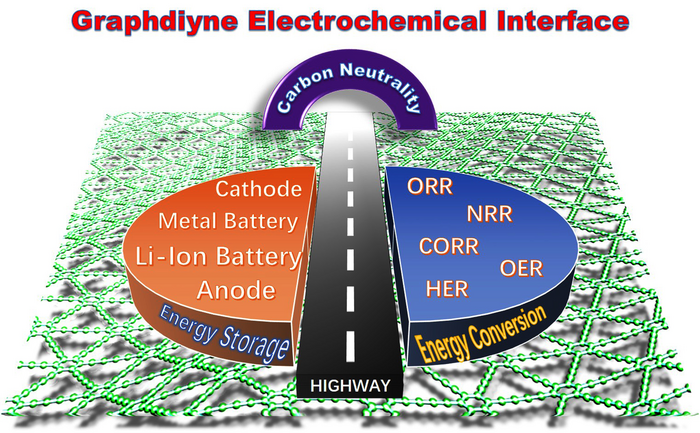Reviewed by Mila PereraOct 27 2022
A synthetic carbon-based crystalline material called graphdiyne (GDY) has progressed from the drawing board to its present status as a potentially key element in driving the next leap in battery technology, one not seen since lithium surpassed lead and heavy metals in the early 1990s.

Graphdiyne has been shown in laboratory settings to be useful in a wide array of applications supporting the electrical energy ecosystem, ranging from production and transmission to next-generation storage and water splitting. The nano-thin material greatly increases efficiency by providing a path of very low resistance for electrical energy, effectively making it a next generation semiconductor. Image Credit: Nano Research Energy, Tsinghua University Press
Professor Zicheng Zuo, a member of the graphdiyne original team in the Chinese Academy of Sciences, Institute of Chemistry, has published a review paper on GDY’s development and its use as an interface component of energy storage and conversion.
Due to the inherent characteristics of GDY, some new phenomena and properties have been discovered in a wide range of research fields. GDY has made substantial breakthroughs in fundamental and applied science, formed innovative scientific concepts and made great achievements.
Zicheng Zuo, Professor and Member, Graphdiyne Original Team, Chinese Academy of Sciences
The study was reported in the Nano Research Energy journal on October 25th, 2022.
Among the achievements of GDYs, the authors concentrated mainly on the 2-D crystal’s potential as it pertains to energy conversion and storage.
In the global fight to decrease carbon emissions, the scientific community has been driven to determine methods of achieving the maximum results from renewable energy sources.
Zuo explained that improved energy storage is a primary part of this. Considerable enhancements in mass energy storage will help optimize the efficient yield of wind and solar. The hourly output of each differs considerably based on weather and time of day.
Graphdiyne is an endlessly scalable crystalline lattice that can hold a charge and provides little resistance upon discharge, thereby making it an ideal battery anode for the next generation of high-tech batteries that would make mass renewable energy reserves workable and electric vehicles accessible to a much broader market.
Research strongly indicates that the graphdiyne interface has strong potential for mass-market applications of high-energy density batteries and water splitting, which are important fields for creating a sustainable society. We firmly believe that these materials will bring transformative progress for energy storage and conversion in five to ten years.
Zicheng Zuo, Professor and Member, Graphdiyne Original Team, Chinese Academy of Sciences
Zuo's team analyzed the potential of graphdiyne as an interface between the building blocks of several batteries. This includes magnesium, potassium, sodium, and lithium, all of which are being extensively studied for use in future energy storage.
The findings over various experiments with different energy storage use displayed that graphdiyne seems to be a highly effective conductor of electricity. This enables the current to pass along a path with minimum resistance.
Also, graphdiyne held up as stable over time, making it a suitable subject of study for real-world energy storage applications in the future.
Stability and controllability are two unprecedented advantages of a graphdiyne interface, and it has the potential to revolutionize the interfacial stability and functions in real scenarios.
Zicheng Zuo, Professor and Member, Graphdiyne Original Team, Chinese Academy of Sciences
Since graphdiyne is known as a crystalline lattice grown in accurately controlled laboratory settings, faster ways of producing it must be discovered to make it feasible for public infrastructure-scale and commercial industrial applications. Zuo stated that he and his collaborators will continue to study the energy storage potential of graphdiyne.
Zuo stated, “In the future, we will scale up the research and build large-scale prototype devices to show the advantages of the graphdiyne interface in advancing the energy density and lifespan of batteries.”
Journal Reference
Gao, X., et al. (2022) Advanced electrochemical energy storage and conversion on graphdiyne interface. Nano Research Energy. doi.org/10.26599/NRE.2022.9120036.